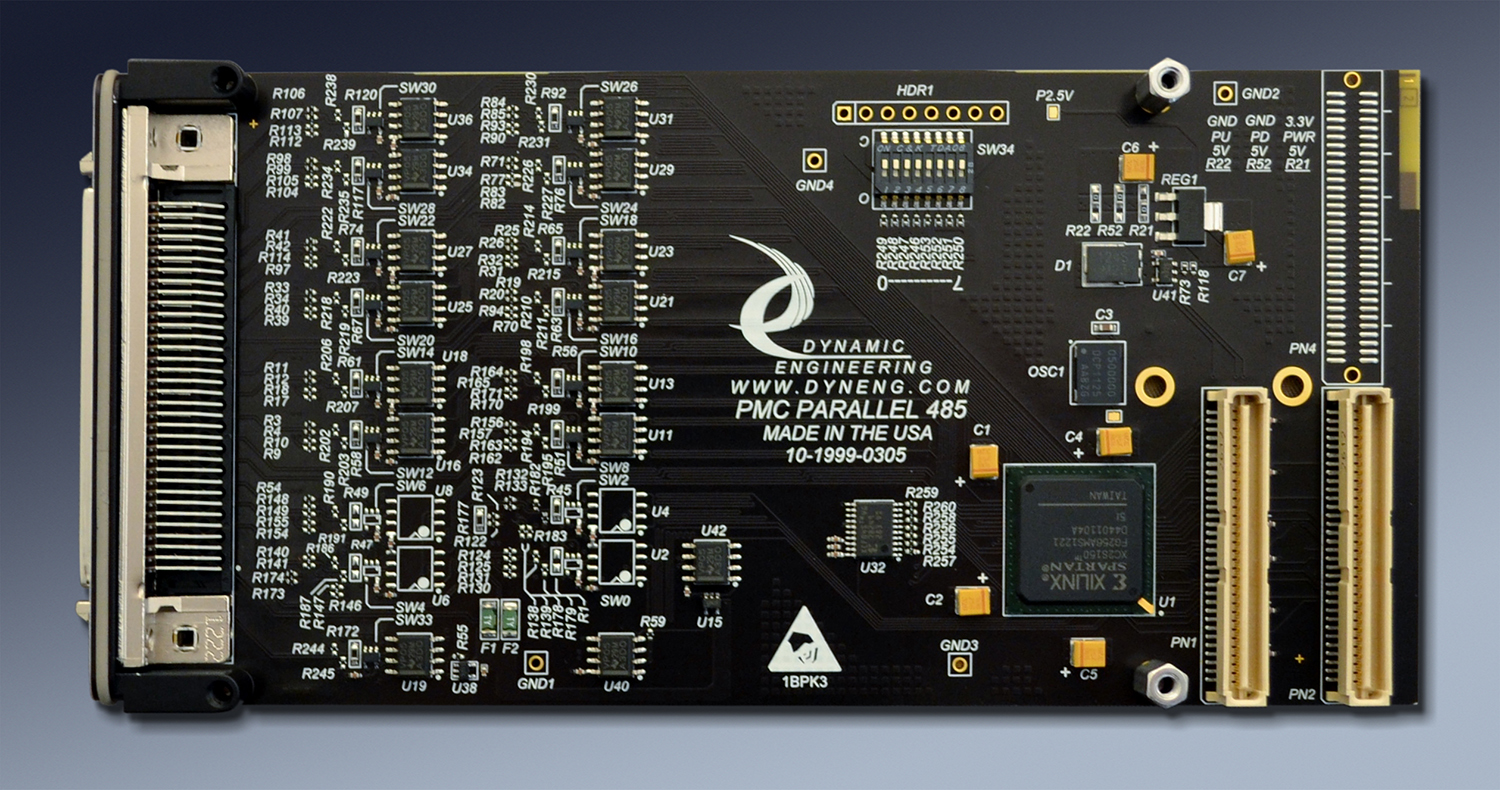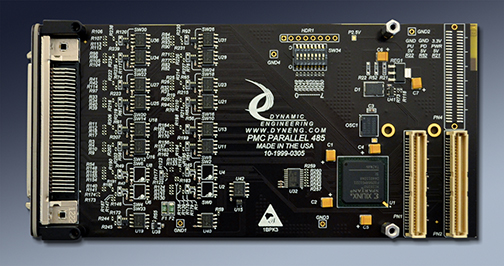PMC-Parallel-485
PMC Module with 32 differential IO
Order This Item


PMC-Parallel-485 Description
- Driver [Win or Linux] included with purchase.
- Standard PMC module
- PCI 32/33 with dipswitch for positive card identification in multi-card installations
- 34 differential IO. 485 Standard. LVDS Option
- GPIO or programmed function
- Bezel and/or rear IO
- FPGA with BRAM for FIFO or RAM implementation
- 1 year warranty standard. Extended warranty available.
- Extended [Industrial] Temperature standard.
- ROHS and Standard processing available
A simple "point and shoot" interface makes it easy to add up to 34 differential IO to your system with the PMC-Parallel-485. The PMC compatible PMC-Parallel-485 design adds 32 [RS-485 /RS-422/LVDS] differential IO lines to one slot of your carrier board. 2 additional differential pairs are available for a clock & clock enable. The signals can be used to capture data with an external reference or programmed to be references for the rest of the system. Many standard features and ease of VHDL updating make PMC-Parallel-485 a versatile design. PMC-Parallel-485 is a companion design for PMC-BiSerial-VI. The Biserial has a larger more capable FPGA and is intended for larger designs. PMC-Parallel-485 is a lower cost version with many of the same features scaled for smaller requirements. In addition ccPMC-BiSerial-VI incorporates conduction cooling - for the really tough design requirements.
If you see a PMC-BiSerial-XXX or XM based design that has more "channels" than you need we can likely port a reduced version to PMC-Parallel-485.
Each differential port is software programmable to be an input or an output. The lower four bits are independent. The rest are programmed on a nibble basis.
Each port is software programmable to be terminated or not. The lower four bits are independent. The rest of the bits are programmed on a nibble [4 bit group] basis.
Options to use a high density 68 pin SCSI III front panel connector and / or Pn4 to provide system IO. The connections to the front and rear IO are isolated to remove the unused trace length from your implementation. All IO is routed differentially with controlled impedance, and matching lengths to the front panel or Pn4.
The IO channels can be used as interrupt generators. Interrupts are programmable to be based on level or edge and active high or low. The registers are mapped as 32 bit words and support byte, word and 32 bit access. All registers are read-writeable.
An 8 bit user switch is provided to allow custom configurations to be easily and automatically configured with a common software driver. For example; the switch can be read through the status port and used to determine what the RX/TX configuration should be and any special characteristics for that implementation.
Certain IO lines have secondary purposes based on build options. Fused power, receive and repeat etc. Additional customization can be implemented to meet client requirements. All of the data bits pass through the FPGA used to implement the PCI interface. Any or all bits can be used for custom state machine and IO functions. Custom termination options are also available. Line selectable pull-up and pull-down resistor postions are available. Please contact Dynamic Engineering with your requirements.
A new custom version can be implemented in a very reasonable time. Typically a few weeks of design time for a medium sized project including the new VHDL set, Windows® , Linux or VxWorks driver, reference software package, and documentation. Click on the models tab for the base version and any client versions created to date - see if the configuration you need already exists or if we need to work on a custom version for you.
We can be rapid with our response because the designs are structured to allow channels to be moved in and out to create new design sets. Most designs have a fairly large component of reused "known good" VHDL that we can pull from allowing us to focus on the new functions required for your implementation. You receive the benefit of many man-years of design and test time with each new version created. Join our high reliability clients by taking advantage of our know-how to help speed your project to completion.
PMC-Parallel-485 can be used along with a PCIe or other carrier/adapter to use with a variety of system types - PCI, PCIe, PC104p, VPX cPCI, etc.. Dynamic Engineering has PMC carriers for PCI, PCIexpress, cPCI, PC104p, and can do custom design´s specific to client requirements as well. Please use the handy pull-down menu at the top of any page to navigate to other Dynamic Engineering products including carriers.
PMCs are independently specified through VITA for the form factor, connectors and pinouts of the PCI signaling; you can use PMC-Parallel-485 design with any carrier from any vendor that supports standard PMCs. To make it even easier the PMC-Parallel-485 has a universal PCI design to allow operation with VIO set to 3.3 or 5V.
It all starts with the PCB [Printed Circuit Board]. Quality design and quality materials are required to meet the strenuous requirements of many of our implementations. You can do the job quickly or you can do the design correctly. We pride ourselves on taking the time to put the extra work into our layouts. The quality goes in before the parts go on. In addition to routing strategy and layer counts, Via size, plating requirements, break-out trace widths, and materials are areas where quality comes into play. The via size and method of trace attachment to the via affect the signal shape and reliability. Using tear-drop trace connections to pads, vias and through hole components enhance the reliability and minimize the impedance discontinuity resulting in a cleaner signal. Using 8/10/12 mil vias provides adequate copper for proper power distribution and more surface area to bond to where traces are interconnected. The combination provides better vibration endurance than smaller vias and traces would provide. The design has several power planes with sufficient copper weight and coverage to provide the references required for the routing plus the current and voltages needed by the various devices on the board. The larger features make the design work more difficult since there is less room to "play with" and the end result is worth it.
The PCI interface has a published set of requirements for compliance which restrict length, impedance, loading and other factors. PMC-Parallel-485 is compliant with the PCI Specification.
The IO is available through either the front panel mounted SCSI connector or Pn4 or some combination. Each IO is isolated from the connectors with zero ohm resistors. The resistors are mounted front and rear and tied together at each pin to allow for a stub length of 1/16th in. The Connectors are routed from the resistor directly allowing for almost zero stub lengths and the option to connect front or rear IO options.
If your situation demands a custom application we will update the Xilinx FPGA and IO components. Send us your description and we will send you the interface. Please refer to the "Models" page for previously completed "customerized" PMC-Parallel-485 implementations.
email us your wish list or call today
PMC Modules require a "carrier" in most cases to adapt them to the system. Dynamic Engineering has carrier solutions for a variety of formats.
PCIe implementations can be done with the PCIeBPMCX1 and PCIeBPMCX2.
PCI implementations can be done with the PCI2PMC and PCIBPMCX2.
cPCI 3U is supported with the cPCIBPMC3U64
cPCI 6U is supported with the cPCIBPMC6U.
PCI-104 is supported with the PCI104p2PMC.
Rev 01 PCB - original release with Spartan FPGA - 1999
Rev 02 PCB - Change to 3.3V IO devices, add LVDS capability - 2000
Rev 03 PCB - minor fab correction to SW9 - 2001
Rev 04 PCB - update to Spartan II, new switch package - 2012
Rev 05 PCB - misc. clean-up. package changes for manufacturing - 2013
Rev 06 PCB - Update to S6-25 FPGA, QSPI flash, termination switches - 2024
If you see a PMC-BiSerial-XXX or XM based design that has more "channels" than you need we can likely port a reduced version to PMC-Parallel-485.
Each differential port is software programmable to be an input or an output. The lower four bits are independent. The rest are programmed on a nibble basis.
Each port is software programmable to be terminated or not. The lower four bits are independent. The rest of the bits are programmed on a nibble [4 bit group] basis.
Options to use a high density 68 pin SCSI III front panel connector and / or Pn4 to provide system IO. The connections to the front and rear IO are isolated to remove the unused trace length from your implementation. All IO is routed differentially with controlled impedance, and matching lengths to the front panel or Pn4.
The IO channels can be used as interrupt generators. Interrupts are programmable to be based on level or edge and active high or low. The registers are mapped as 32 bit words and support byte, word and 32 bit access. All registers are read-writeable.
An 8 bit user switch is provided to allow custom configurations to be easily and automatically configured with a common software driver. For example; the switch can be read through the status port and used to determine what the RX/TX configuration should be and any special characteristics for that implementation.
Certain IO lines have secondary purposes based on build options. Fused power, receive and repeat etc. Additional customization can be implemented to meet client requirements. All of the data bits pass through the FPGA used to implement the PCI interface. Any or all bits can be used for custom state machine and IO functions. Custom termination options are also available. Line selectable pull-up and pull-down resistor postions are available. Please contact Dynamic Engineering with your requirements.
A new custom version can be implemented in a very reasonable time. Typically a few weeks of design time for a medium sized project including the new VHDL set, Windows® , Linux or VxWorks driver, reference software package, and documentation. Click on the models tab for the base version and any client versions created to date - see if the configuration you need already exists or if we need to work on a custom version for you.
We can be rapid with our response because the designs are structured to allow channels to be moved in and out to create new design sets. Most designs have a fairly large component of reused "known good" VHDL that we can pull from allowing us to focus on the new functions required for your implementation. You receive the benefit of many man-years of design and test time with each new version created. Join our high reliability clients by taking advantage of our know-how to help speed your project to completion.
PMC-Parallel-485 can be used along with a PCIe or other carrier/adapter to use with a variety of system types - PCI, PCIe, PC104p, VPX cPCI, etc.. Dynamic Engineering has PMC carriers for PCI, PCIexpress, cPCI, PC104p, and can do custom design´s specific to client requirements as well. Please use the handy pull-down menu at the top of any page to navigate to other Dynamic Engineering products including carriers.
PMCs are independently specified through VITA for the form factor, connectors and pinouts of the PCI signaling; you can use PMC-Parallel-485 design with any carrier from any vendor that supports standard PMCs. To make it even easier the PMC-Parallel-485 has a universal PCI design to allow operation with VIO set to 3.3 or 5V.
It all starts with the PCB [Printed Circuit Board]. Quality design and quality materials are required to meet the strenuous requirements of many of our implementations. You can do the job quickly or you can do the design correctly. We pride ourselves on taking the time to put the extra work into our layouts. The quality goes in before the parts go on. In addition to routing strategy and layer counts, Via size, plating requirements, break-out trace widths, and materials are areas where quality comes into play. The via size and method of trace attachment to the via affect the signal shape and reliability. Using tear-drop trace connections to pads, vias and through hole components enhance the reliability and minimize the impedance discontinuity resulting in a cleaner signal. Using 8/10/12 mil vias provides adequate copper for proper power distribution and more surface area to bond to where traces are interconnected. The combination provides better vibration endurance than smaller vias and traces would provide. The design has several power planes with sufficient copper weight and coverage to provide the references required for the routing plus the current and voltages needed by the various devices on the board. The larger features make the design work more difficult since there is less room to "play with" and the end result is worth it.
The PCI interface has a published set of requirements for compliance which restrict length, impedance, loading and other factors. PMC-Parallel-485 is compliant with the PCI Specification.
The IO is available through either the front panel mounted SCSI connector or Pn4 or some combination. Each IO is isolated from the connectors with zero ohm resistors. The resistors are mounted front and rear and tied together at each pin to allow for a stub length of 1/16th in. The Connectors are routed from the resistor directly allowing for almost zero stub lengths and the option to connect front or rear IO options.
If your situation demands a custom application we will update the Xilinx FPGA and IO components. Send us your description and we will send you the interface. Please refer to the "Models" page for previously completed "customerized" PMC-Parallel-485 implementations.
email us your wish list or call today
PMC Modules require a "carrier" in most cases to adapt them to the system. Dynamic Engineering has carrier solutions for a variety of formats.
PCIe implementations can be done with the PCIeBPMCX1 and PCIeBPMCX2.
PCI implementations can be done with the PCI2PMC and PCIBPMCX2.
cPCI 3U is supported with the cPCIBPMC3U64
cPCI 6U is supported with the cPCIBPMC6U.
PCI-104 is supported with the PCI104p2PMC.
PMC-Parallel-485 Features
Size
Std PMC 74mm x 149mm nominal. Low profile components on rear
IO
IO is available via the PMC bezel connector and / or the PMC "user IO" connector Pn4. The IO is properly routed with impedance control. 0 ohm resistors are used to isolate the front and rear panel IO. 32 differential pairs at Pn4 and 32 + 2 at the bezel.
Clocks
33 MHz PCI, Oscillator counters / Dividers / DCM for local clock control.
Interface Types
Custom programmed interfaces are available. Please send us a description, and we can program one for you. Most interfaces can be adapted from our large library of designs within a few weeks including the updated VHDL, Windows or Linux Driver, reference manuals etc. We can support on-site [ours] integration to help you get your application level software working.
Alternatively choose one of the already completed versions and purchase off-the-shelf.
Alternatively choose one of the already completed versions and purchase off-the-shelf.
Memory
Xilinx FPGA is standard and has BRAMs to create RAM, FIFO etc.
Software Interface
Control registers are read-writeable
Windows®, Linux, VxWorks reference SW and Drivers.
Windows®, Linux, VxWorks reference SW and Drivers.
Interrupts
Software programmable interrupts based on design implemented. Status can be polled for non-interrupt driven operation as well. GPIO model has interrupt capabilities on each IO.
Power Requirement
+5V converted to 1.2V and 2.5V. 3.3V used directly. LED indicating 1.2V within tolerance.
External Clock
Input registers are programmable to capture data on the internal clock, user oscillator or external user supplied clock. Additionally an external clock enable input is provided to allow selective clocks be gated at the register. SW can select internal or external
Volatility
Reliability
TBD million hours. Bellcore. GB 25c
PMC-Parallel-485 Benefits
Speed
PMC-Parallel-485 can offload the CPU with COS processing on your IO. No need to poll, let interrupts tell the CPU when an event has happened. For custom designs memory elements can allow higher speed transfer to the device and metered IO to the external equipment. For multiple port DMA based IO PMC-BiSerial-VI is recommended.
Price
System level cost is best when reasonably priced reliable hardware is used and NRE minimized. With PMC-Parallel-485, driver support, reference software, history of reliable operation, and fantastic client support your cost per unit and overall costs are attractive.
Ease of Use
PMC-Parallel-485 is designed to be easy-to-use. Direct access to all features, aligned registers for larger access types, programmable features to allow personalization for your system. Please download the manuals and see for yourself. Reference software is provided in source form to get you started.
Availability
There are two basic models with front or rear IO types. The standard version of both are stocked items. "Stocked" means we utilize our in-house manufacturing capability to keep inventory and can recover quickly if temporarily sold out or larger orders are received. Conformal coating is done on a per order basis.
PMC Specification Compatibility
PMC-Parallel-485 is compliant per the VITA PMC/CMC specifications. Tested with PCI and PCIe based carriers. All Dynamic Engineering PMC Modules are compatible with the PCIeBPMCX1, PMC-Parallel-485 will operate with any PMC specification compliant carrier board.
Part Number: PMC-Parallel-485
Ordering Options
- PMC-Parallel-485 Standard board - with RS-485 bezel IO , Industrial temperature components.
- -RIO Switch to Pn4 [Rear] IO, comes with blank bezel
- -FRP Both Bezel and RIO options
- -LVDS Switch to LVDS IO type
- -ROHS Use ROHS processing. Standard processing is ""leaded"
- -CC Option to add Conformal Coating
- -XXX See Manuals section for customized versions and replace XXX with type
PMC-Parallel-485 Drivers
Software Support for PMC-Parallel-485-XXX includes: Windows, and Linux compliant drivers
Please see the Driver manuals for the specifics of each type.
Drivers and Reference SW are developed for each type / version of PMC-Parallel-485 implemented. When custom versions are ordered the NRE will include providing Windows, Linux, and or VxWorks packages. For off-the-shelf models, select on the manuals tab, the Windows® and Linux SW shown is included with your purchase of the HW. Unsupported SW versions may have an NRE requirement.
Integration support is available. Please contact Dynamic Engineering for this option or download the Technical Support Description from the Company button.
Please see the Driver manuals for the specifics of each type.
Drivers and Reference SW are developed for each type / version of PMC-Parallel-485 implemented. When custom versions are ordered the NRE will include providing Windows, Linux, and or VxWorks packages. For off-the-shelf models, select on the manuals tab, the Windows® and Linux SW shown is included with your purchase of the HW. Unsupported SW versions may have an NRE requirement.
Integration support is available. Please contact Dynamic Engineering for this option or download the Technical Support Description from the Company button.
PMC-Parallel-485 Models
Standard Model with register based IO, programmable interrupts per IO, programmable direction and termination. RS-485, LVDS or mixed IO
Download the PMC-Parallel-485 Manual
Download the PMC-Parallel-485 Win10 manual
Add the extension to the Part Number to get these models
-NG1..........PMC-Parallel-485-NG1
Modified version with programmable counter timers, alternate interrupt implementation, clock generators and more. Eight user bits are supplied for user configuration control. Two clock generators are provided. Each generator can be referenced to either the external source, the local oscillator [2 MHz] or the PCI clock/2. The generators are programmable [12 bits]. The generated frequencies are then used as the reference for two counters. One counter is 32 bits wide and the other is 14. Some IO are replaced with alternate functions. One signal is received and two copies redriven. Fused power and additional grounds are implemented. Bezel based IO.
The output of the counters is available via the PCI bus. The output of the 32 bit counter is captured based on the state of the 14 bit counter, and available from a second register. Interrupts can be generated when specific [programmed] counter bits roll over. The 32 bit counter can be used for Time of Day requirements with the 14 bit counter used to time events.
Download the PMC-Parallel-485 NG1 Hardwre Manual with description, memory map, bit map, pinout etc.
Download the PMC-Parallel-485 NG1 Win10/11 Manual
Download the PMC-Parallel-485-NG1 Linux Manual
-NRC1..........PMC-Parallel-485-NRC1
Modified version with interrupt on change of state capability, upper bits muxed to allow input buffering or discrete outputs, and upper nibble predefined as output.
Download the PMC-Parallel-485 NRC1 version Manual
Download the PMC-Parallel-485 Manual
Download the PMC-Parallel-485 Win10 manual
Add the extension to the Part Number to get these models
-NG1..........PMC-Parallel-485-NG1
Modified version with programmable counter timers, alternate interrupt implementation, clock generators and more. Eight user bits are supplied for user configuration control. Two clock generators are provided. Each generator can be referenced to either the external source, the local oscillator [2 MHz] or the PCI clock/2. The generators are programmable [12 bits]. The generated frequencies are then used as the reference for two counters. One counter is 32 bits wide and the other is 14. Some IO are replaced with alternate functions. One signal is received and two copies redriven. Fused power and additional grounds are implemented. Bezel based IO.
The output of the counters is available via the PCI bus. The output of the 32 bit counter is captured based on the state of the 14 bit counter, and available from a second register. Interrupts can be generated when specific [programmed] counter bits roll over. The 32 bit counter can be used for Time of Day requirements with the 14 bit counter used to time events.
Download the PMC-Parallel-485 NG1 Hardwre Manual with description, memory map, bit map, pinout etc.
Download the PMC-Parallel-485 NG1 Win10/11 Manual
Download the PMC-Parallel-485-NG1 Linux Manual
-NRC1..........PMC-Parallel-485-NRC1
Modified version with interrupt on change of state capability, upper bits muxed to allow input buffering or discrete outputs, and upper nibble predefined as output.
Download the PMC-Parallel-485 NRC1 version Manual


